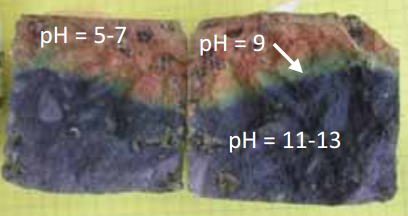CARBONATION EVALUATION
Why test for Concrete Carbonation?
Concrete structures exposed to carbon dioxide in the environment suffer from a degenerative phenomenon called carbonation. Carbon dioxide is released into our atmosphere as part of the process of fuel combustion. For that reason, any structure located in urban areas is exempt from presenting this phenomenon. CO2, in conjunction with moisture (water), turns the calcium hydroxide with high pH levels into calcium carbonate, which has a neutral pH and makes it easy for the reinforcing steel to start corrosion. Once corrosion is started, there is no turning back. Carbonation is a phenomenon that also increases the concrete compressive strength. However, the induced corrosion by the carbonation phenomenon may cause the end of the service life of the structure.
To extend the life of a structure, carbonation contaminated concrete should be replaced by new repair materials.
Carbonation Analysis
By means of a Selective Phenolphthalein liquid we can evaluate the carbonation degree in the concrete coverlayer. To determine accurately the carbonation penetration we drill out a little concrete core or concrete dust at different depths.
Our services can be used to determine the Carbonation Depth in the following structures:
– Parking Lots
– Shipping Docks
– Bridge Decks
– Bridge Piers
– Columns
– Buildings in coastal zones





